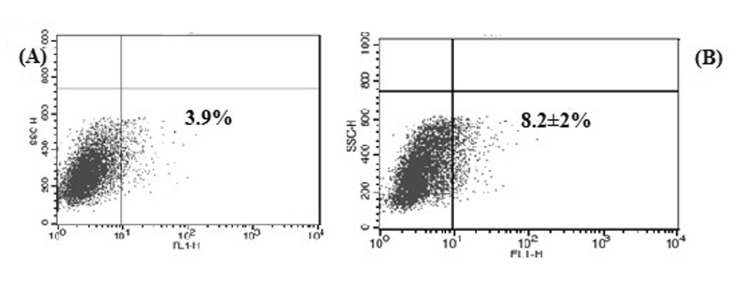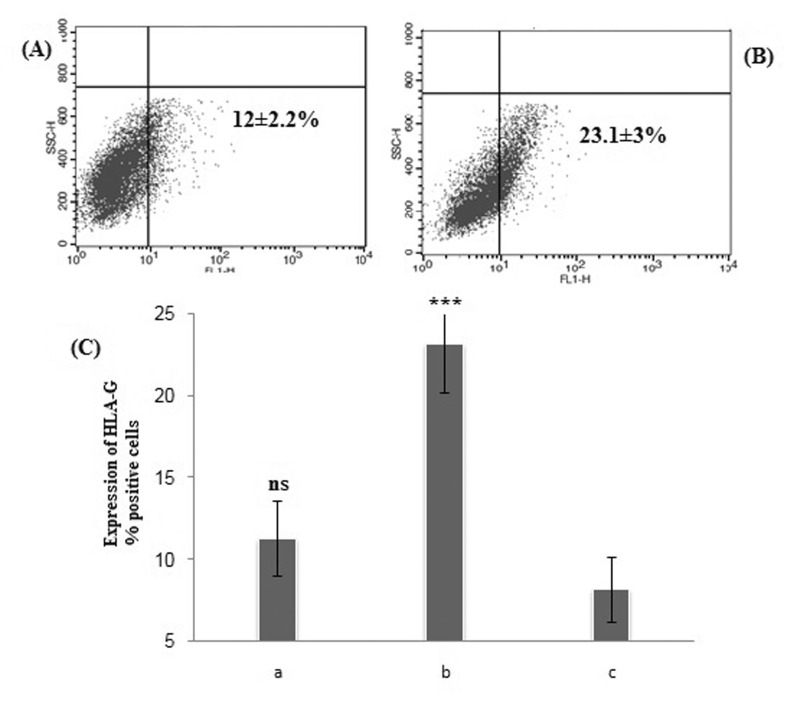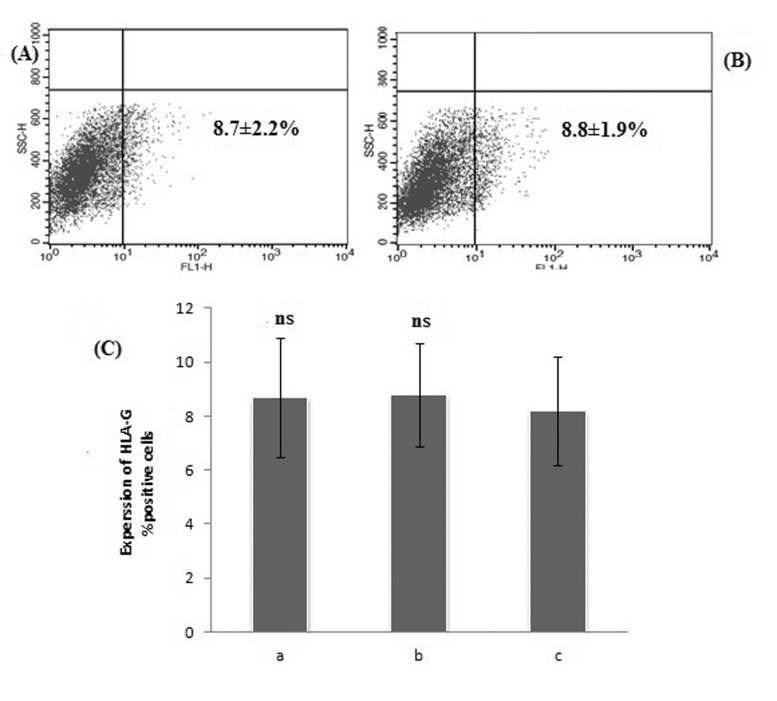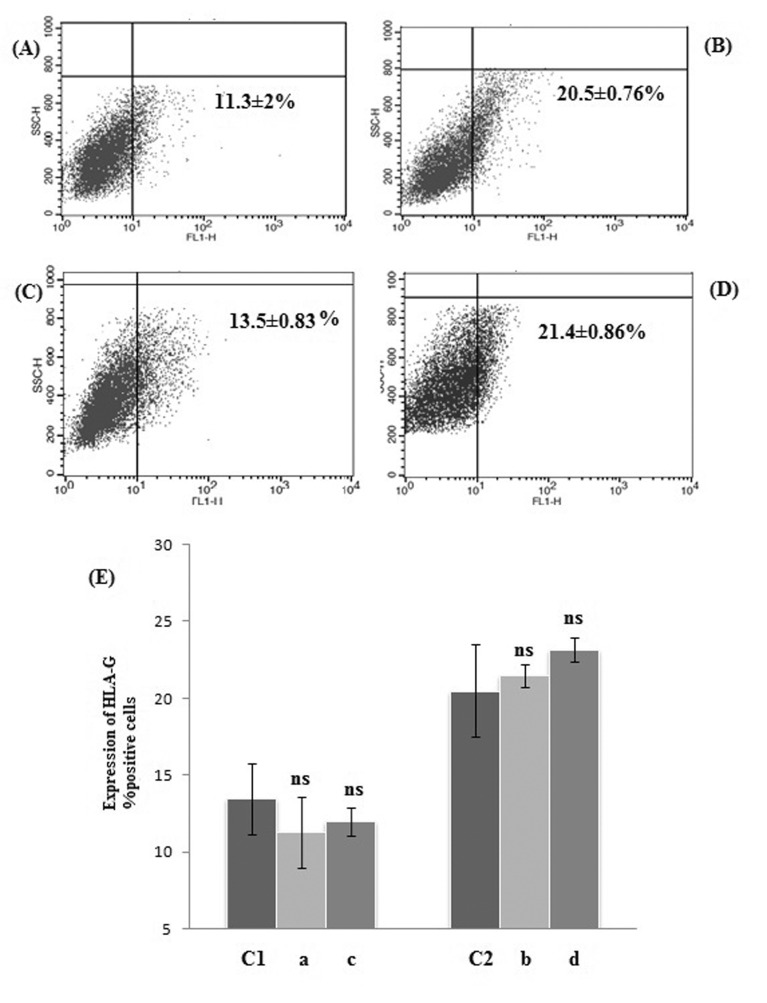Korean J Physiol Pharmacol.
2016 Jul;20(4):341-346. 10.4196/kjpp.2016.20.4.341.
The effect of progesterone and 17-β estradiol on membrane-bound HLA-G in adipose derived stem cells
- Affiliations
-
- 1Department of Immunology, Medical School, Isfahan University of Medical Sciences, Isfahan 81746-73461, Iran. adib@med.mui.ac.ir
- 2Department of Anatomical Science and Molecular Biology, Medical School, Isfahan University of Medical Sciences, Isfahan 81746-73461, Iran.
- 3Department of Physiology & Pharmacology, Medical School, Qom University of Medical Sciences, Qom 3713649373, Iran.
- KMID: 2371051
- DOI: http://doi.org/10.4196/kjpp.2016.20.4.341
Abstract
- Membrane-bound HLA-G (mHLA-G) discovery on adipose derived stem cells (ADSCs) as a tolerogenic and immunosuppressive molecule was very important. Many documents have shown that HLA-G expression can be controlled via some hormones such as progesterone (P4) and estradiol (E2). Therefore, this study was designed to evaluate progesterone and estradiol effects on mHLA-G in ADSCs at restricted and combination concentrations. Three independent cell lines were cultured in complete free phenol red DMEM and subcultured to achieve suffi cient cells. These cells were treated with P4, E2 and P4 plus E2 at physiologic and pregnancy concentrations for 3 days in cell culture conditions. The HLA-G positive ADSCs was measured via monoclonal anti HLA-G-FITC/MEMG-09 by means of flow cytometry in nine groups. Data were analyzed by one way ANOVA and Tukey's post hoc tests. There were no signifi cant values of the mean percentage of HLA-G positive cells in E2-treated and the combination of P4 plus E2-treated ADSCs compared to control cells (p value>0.05) but P4 had a signifi cant increase on mHLA-G in ADSCs (p value<0.05). High P4 concentration increased mHLA-G but E2 and the combination of P4 plus E2 could not change mHLA-G on ADSCs.
MeSH Terms
Figure
Reference
-
1. Wei X, Yang X, Han ZP, Qu FF, Shao L, Shi YF. Mesenchymal stem cells: a new trend for cell therapy. Acta Pharmacol Sin. 2013; 34:747–754. PMID: 23736003.
Article2. Choi JS, Leem JW, Lee KH, Kim SS, Suh-Kim H, Jung SJ, Kim UJ, Lee BH. Effects of human mesenchymal stem cell transplantation combined with polymer on functional recovery following spinal cord hemisection in rats. Korean J Physiol Pharmacol. 2012; 16:405–411. PMID: 23269903.
Article3. Alipour R, Sadeghi F, Hashemi-Beni B, Zarkesh-Esfahani SH, Heydari F, Mousavi SB, Adib M, Narimani M, Esmaeili N. Phenotypic characterizations and comparison of adult dental stem cells with adipose-derived stem cells. Int J Prev Med. 2010; 1:164–171. PMID: 21566786.4. Puissant B, Barreau C, Bourin P, Clavel C, Corre J, Bousquet C, Taureau C, Cousin B, Abbal M, Laharrague P, Penicaud L, Casteilla L, Blancher A. Immunomodulatory effect of human adipose tissue-derived adult stem cells: comparison with bone marrow mesenchymal stem cells. Br J Haematol. 2005; 129:118–129. PMID: 15801964.
Article5. Shi M, Liu ZW, Wang FS. Immunomodulatory properties and therapeutic application of mesenchymal stem cells. Clin Exp Immunol. 2011; 164:1–8. PMID: 21352202.
Article6. Nauta AJ, Fibbe WE. Immunomodulatory properties of mesenchymal stromal cells. Blood. 2007; 110:3499–3506. PMID: 17664353.
Article7. Amodio G, Gregori S. Distinctive immunological functions of HLA-G. Division of regenerative medicine, stem cells and gene therapy. 2nd ed. Milan, Italy: San Raffaele Scientific Institute;2012. 5.8. Castelli EC, Veiga-Castelli LC, Yaghi L, Moreau P, Donadi EA. Transcriptional and posttranscriptional regulations of the HLA-G Gene. J Immunol Res. 2014; 2014.9. Yie SM, Xiao R, Librach CL. Progesterone regulates HLA-G gene expression through a novel progesterone response element. Hum Reprod. 2006; 21:2538–2544. PMID: 16684846.
Article10. Carosella ED, Moreau P, Le Maoult J, Le Discorde M, Dausset J, Rouas-Freiss N. HLA-G molecules: from maternal-fetal tolerance to tissue acceptance. Adv Immunol. 2003; 81:199–252. PMID: 14711057.
Article11. Corcione A, Benvenuto F, Ferretti E, Giunti D, Cappiello V, Cazzanti F, Risso M, Gualandi F, Mancardi GL, Pistoia V, Uccelli A. Human mesenchymal stem cells modulate B-cell functions. Blood. 2006; 107:367–372. PMID: 16141348.
Article12. DelaRosa O, Lombardo E, Beraza A, Mancheño-Corvo P, Ramirez C, Menta R, Rico L, Camarillo E, García L, Abad JL, Trigueros C, Delgado M, Büscher D. Requirement of IFN-gamma-mediated indoleamine 2,3-dioxygenase expression in the modulation of lymphocyte proliferation by human adipose-derived stem cells. Tissue Eng Part A. 2009; 15:2795–2806. PMID: 19231921.13. Tatara R, Ozaki K, Kikuchi Y, Hatanaka K, Oh I, Meguro A, Matsu H, Sato K, Ozawa K. Mesenchymal stromal cells inhibit Th17 but not regulatory T-cell differentiation. Cytotherapy. 2011; 13:686–694. PMID: 21171824.
Article14. Hunt JS, Jadhav L, Chu W, Geraghty DE, Ober C. Soluble HLA-G circulates in maternal blood during pregnancy. Am J Obstet Gynecol. 2000; 183:682–688. PMID: 10992193.
Article15. Zhao X, Liu L, Liu D, Fan H, Wang Y, Hu Y, Hou Y. Progesterone enhances immunoregulatory activity of human mesenchymal stem cells via PGE2 and IL-6. Am J Reprod Immunol. 2012; 68:290–300. PMID: 22747921.
Article16. Yun SP, Lee MY, Ryu JM, Song CH, Han HJ. Role of HIF-1alpha and VEGF in human mesenchymal stem cell proliferation by 17beta-estradiol: involvement of PKC, PI3K/Akt, and MAPKs. Am J Physiol Cell Physiol. 2009; 296:C317–C326. PMID: 18987249.17. Ragerdi Kashani I, Hedayatpour A, Pasbakhsh P, Kafami L, Atlasi N, Pirhajati Mahabadi V, Mamoudi R, Baazm M. 17β-Estradiol enhances the efficacy of adipose-derived mesenchymal stem cells on remyelination in mouse model of multiple sclerosis. Acta Med Iran. 2012; 50:789–797. PMID: 23456519.18. Ing NH, Tornesi MB. Estradiol up-regulates estrogen receptor and progesterone receptor gene expression in specific ovine uterine cells. Biol Reprod. 1997; 56:1205–1215. PMID: 9160720.19. O'Malley BW, Sherman MR, Toft DO. Progesterone "receptors" in the cytoplasm and nucleus of chick oviduct target tissue. Proc Natl Acad Sci U S A. 1970; 67:501–508. PMID: 5289005.20. Ansar MM, Esfandiariy E, Mardani M, Hashemibeni B, Zarkesh-Esfahani SH, Hatef M, Kabiri A. A comparative study of aggrecan synthesis between natural articular chondrocytes and differentiated chondrocytes from adipose derived stem cells in 3D culture. Adv Biomed Res. 2012; 1:24. PMID: 23210083.
Article21. Cohen-Solal K, Bailly A, Rauch C, Quesne M, Milgrom E. Specific binding of progesterone receptor to progesterone-responsive elements does not require prior dimerization. Eur J Biochem. 1993; 214:189–195. PMID: 7685278.
Article22. Yie SM, Li LH, Li GM, Xiao R, Librach CL. Progesterone enhances HLA-G gene expression in JEG-3 choriocarcinoma cells and human cytotrophoblasts in vitro. Hum Reprod. 2006; 21:46–51. PMID: 16210391.
Article23. Nasef A, Mathieu N, Chapel A, Frick J, François S, Mazurier C, Boutarfa A, Bouchet S, Gorin NC, Thierry D, Fouillard L. Immunosuppressive effects of mesenchymal stem cells: involvement of HLA-G. Transplantation. 2007; 84:231–237. PMID: 17667815.
Article24. Blanco O, Tirado I, Muñoz-Fernández R, Abadía-Molina AC, García-Pacheco JM, Peña J, Olivares EG. Human decidual stromal cells express HLA-G: Effects of cytokines and decidualization. Hum Reprod. 2008; 23:144–152. PMID: 17951263.
Article25. Sheshgiri R, Rao V, Tumiati LC, Xiao R, Prodger JL, Badiwala M, Librach C, Delgado DH. Progesterone induces human leukocyte antigen-g expression in vascular endothelial and smooth muscle cells. Circulation. 2008; 118(14 Suppl):S58–S64. PMID: 18824770.
Article26. Ivanova-Todorova E, Mourdjeva M, Kyurkchiev D, Bochev I, Stoyanova E, Dimitrov R, Timeva T, Yunakova M, Bukarev D, Shterev A, Tivchev P, Kyurkchiev S. HLA-G expression is up-regulated by progesterone in mesenchymal stem cells. Am J Reprod Immunol. 2009; 62:25–33. PMID: 19527229.27. Mouillot G, Marcou C, Zidi I, Guillard C, Sangrouber D, Carosella ED, Moreau P. Hypoxia modulates HLA-G gene expression in tumor cells. Hum Immunol. 2007; 68:277–285. PMID: 17400064.
Article
- Full Text Links
- Actions
-
Cited
- CITED
-
- Close
- Share
- Similar articles
-
- Progesterone Inhibits the Stimulatory Effect of Estrogen on the Mammotrope Proliferation in Rat Pituitary Cultures
- Interleukin-1 progesterone and estradiol levels of amnoitic fluids in the term pregnant women
- Adipose-derived stem cells: characterization and clinical application
- The effects of acute exercise on plasma concentration of follicular stimulating hormoen(FSH), estradiol, progesterone in women
- Study of serum levels of estradiol, progesterone and ?hCG compare ectopic pregnancy with normal pregnancy





